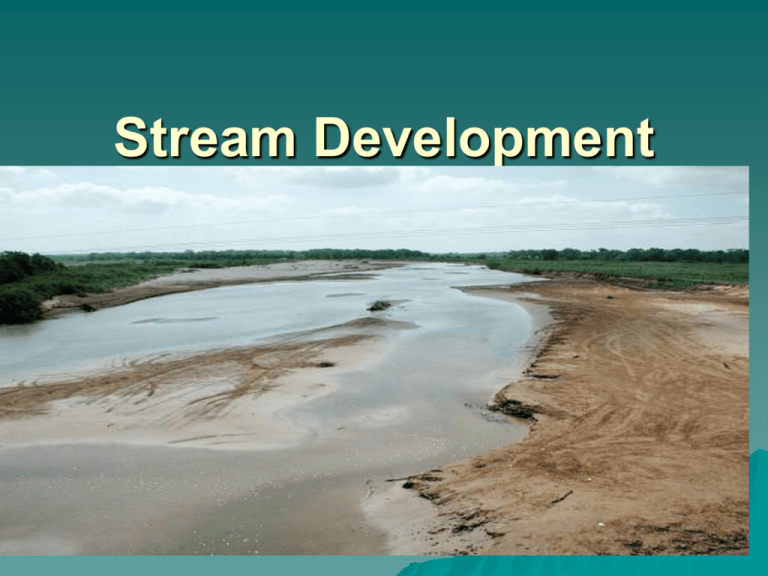Unit 7 day 7 Stream_Development
advertisement

Stream Development Objective 1. Define deposition as the process by which Earth materials carried by wind, water, or ice settle out and are deposited. 2. Describe the agents of erosion: gravity, water (running water and waves), glaciers, and wind. 3. Explain that running water (rivers, streams, and runoff) is the major cause of erosion. Objective 4. Identify the sources of fresh water on the Earth’s surface. 5. Describe the process of stream development and the associated landforms. 6. Design and construct experiments using stream tables to infer relationships between gradient, slope, speed, and extent of weathering and erosion. 7. Explain the types of deposition specific to streams and rivers (such as alluvial fans and deltas). Enduring Understanding Weathering, erosion, and deposition are interrelated processes that form a cycle of forces that wear down and build up the Earth’s surface. Water is continuously passed through the hydrologic cycle. Fresh water is necessary for survival and most human activities. Stream Development As a stream develops it changes shape, width, and size as well as the landscapes over which it flows. Stream Development Streams are responsible for the majority of the landforms we see today Alluvial Fan Stream Development Precipitation supplies the water for the beginnings of stream development Stream Development Headwaters is the region where water first accumulates to supply a stream Stream Development Headwaters are commonly found high in the mountains Stream Development Stream channel is a narrow pathway carved into the sediment or rock by moving water Stream Development Stream bank is the ground bordering each side of the stream Stream Development Stream piracy occurs when one stream draws away water from another Stream Valleys As a stream actively erodes its path through the sediment or rock it develops a specific recognizable landform Stream Valleys V-Shaped channels are formed by streams and have steep sides that form at an angle Stream Valleys Gorges and canyons are very old Vshaped channels Stream Valleys The Grand Canyon formed by the Colorado River is one very recognizable V-shaped valley Stream Valleys Base level is lowest elevation a stream will cut its valley to and coincides with the level of the lake or larger stream it runs into Stream Valleys Sea level is the ultimate base level Meandering Streams As streams continue to cut and widen their channels the amount of water and sediment they can carry increases. Meandering Streams As the stream approaches base level the slope decreases and water builds up it begins to erode the sides of the channel. Meandering Streams Meander is the bend or curve in a stream channel Meandering Streams The water flowing in a stream moves at different speeds. It is fastest in the middle of a straight flowing stream because friction slows the sides and bottom. Meandering Streams When a stream begins to make a turn this changes and forms very interesting features Meandering Streams Water on the outside of the curve flows faster than the water on the inside of the curve Meandering Streams This water erodes away the outside bank and makes the meander even larger Meandering Streams Cut bank is the result of the greater erosion Meandering Streams The slower water on the inside of the curve causes deposition of the sediment Meandering Streams Point Bar is the resulting feature Meandering Streams Oxbow Lakes are meanders that become completely blocked off by deposition of sediment Stream Deposition As streams slow they lose their ability to carry sediment. This is most commonly the result in a decrease in gradient or slope of the landscape over which the stream flows Stream Deposition Alluvial fan is the sloping deposited sediment at the base of a steep slope and is most commonly found at the base of mountains in dry regions Stream Deposition Delta is the triangular deposit that forms when a stream enters a large body of water. Stream Deposition Deltas grow as stream deposition blocks the pathway of the moving water and smaller distributary streams branch out to form their own deposits Stream Deposition The Mississippi River delta began forming millions of years ago but it has deposited enough sediment in just the last 5,000 years to build the city of New Orleans on







